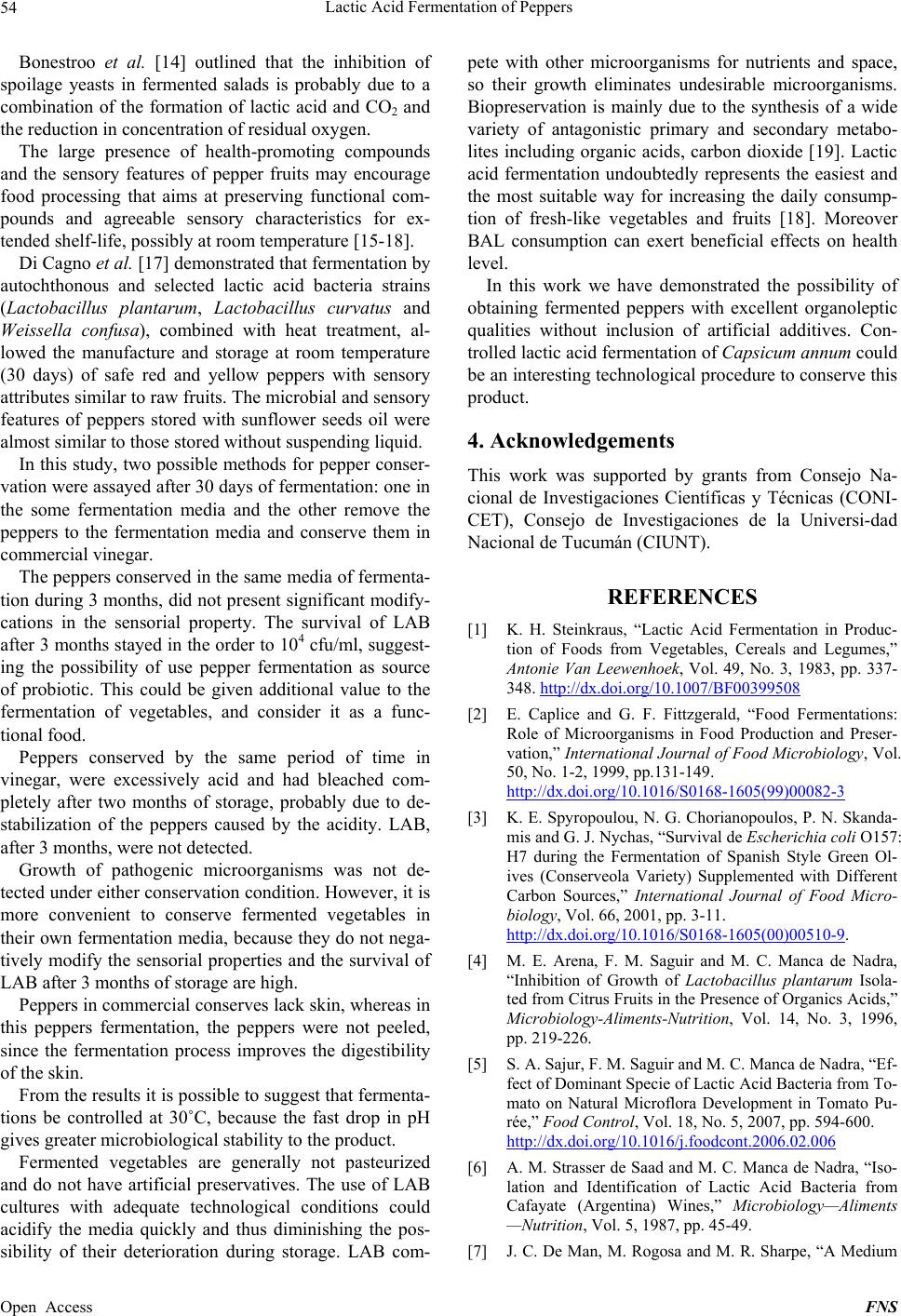
Lactic Acid Fermentation of Peppers
54
Bonestroo et al. [14] outlined that the inhibition of
spoilage yeasts in fermented salads is probably due to a
combination of the formation of lactic acid and CO2 and
the reduction in concentration of residual oxygen.
The large presence of health-promoting compounds
and the sensory features of pepper fruits may encourage
food processing that aims at preserving functional com-
pounds and agreeable sensory characteristics for ex-
tended shelf-life, possibly at room temperature [15-18].
Di Cagno et al. [17] demonstrated that fermentation by
autochthonous and selected lactic acid bacteria strains
(Lactobacillus plantarum, Lactobacillus curvatus and
Weissella confusa), combined with heat treatment, al-
lowed the manufacture and storage at room temperature
(30 days) of safe red and yellow peppers with sensory
attributes similar to raw fruits. The microbial and sensory
features of peppers stored with sunflower seeds oil were
almost similar to those stored without suspending liquid.
In this study, two possible methods for pepper conser-
vation were assayed after 30 days of fermentation: one in
the some fermentation media and the other remove the
peppers to the fermentation media and conserve them in
commercial vinegar.
The peppers conserved in the same media of fermenta-
tion during 3 months, did not present significant modify-
cations in the sensorial property. The survival of LAB
after 3 months stayed in the order to 104 cfu/ml, suggest-
ing the possibility of use pepper fermentation as source
of probiotic. This could be given additional value to the
fermentation of vegetables, and consider it as a func-
tional food.
Peppers conserved by the same period of time in
vinegar, were excessively acid and had bleached com-
pletely after two months of storage, probably due to de-
stabilization of the peppers caused by the acidity. LAB,
after 3 months, were not detected.
Growth of pathogenic microorganisms was not de-
tected under either conservation condition. However, it is
more convenient to conserve fermented vegetables in
their own fermentation media, because they do not nega-
tively modify the sensorial properties and the survival of
LAB after 3 months of storage are high.
Peppers in commercial conserves lack skin, whereas in
this peppers fermentation, the peppers were not peeled,
since the fermentation process improves the digestibility
of the skin.
From the results it is possible to suggest that fermenta-
tions be controlled at 30˚C, because the fast drop in pH
gives greater microbiological stability to the product.
Fermented vegetables are generally not pasteurized
and do not have artificial preservatives. The use of LAB
cultures with adequate technological conditions could
acidify the media quickly and thus diminishing the pos-
sibility of their deterioration during storage. LAB com-
pete with other microorganisms for nutrients and space,
so their growth eliminates undesirable microorganisms.
Biopreservation is mainly due to the synthesis of a wide
variety of antagonistic primary and secondary metabo-
lites including organic acids, carbon dioxide [19]. Lactic
acid fermentation undoubtedly represents the easiest and
the most suitable way for increasing the daily consump-
tion of fresh-like vegetables and fruits [18]. Moreover
BAL consumption can exert beneficial effects on health
level.
In this work we have demonstrated the possibility of
obtaining fermented peppers with excellent organoleptic
qualities without inclusion of artificial additives. Con-
trolled lactic acid fermentation of Capsicum annum could
be an interesting technological procedure to conserve this
product.
4. Acknowledgements
This work was supported by grants from Consejo Na-
cional de Investigaciones Científicas y Técnicas (CONI-
CET), Consejo de Investigaciones de la Universi-dad
Nacional de Tucumán (CIUNT).
REFERENCES
[1] K. H. Steinkraus, “Lactic Acid Fermentation in Produc-
tion of Foods from Vegetables, Cereals and Legumes,”
Antonie Van Leewenhoek, Vol. 49, No. 3, 1983, pp. 337-
348. http://dx.doi.org/10.1007/BF00399508
[2] E. Caplice and G. F. Fittzgerald, “Food Fermentations:
Role of Microorganisms in Food Production and Preser-
vation,” International Journal of Food Microbiology, Vol.
50, No. 1-2, 1999, pp.131-149.
http://dx.doi.org/10.1016/S0168-1605(99)00082-3
[3] K. E. Spyropoulou, N. G. Chorianopoulos, P. N. Skanda-
mis and G. J. Nychas, “Survival de Escherichia coli O157:
H7 during the Fermentation of Spanish Style Green Ol-
ives (Conserveola Variety) Supplemented with Different
Carbon Sources,” International Journal of Food Micro-
biology, Vol. 66, 2001, pp. 3-11.
http://dx.doi.org/10.1016/S0168-1605(00)00510-9.
[4] M. E. Arena, F. M. Saguir and M. C. Manca de Nadra,
“Inhibition of Growth of Lactobacillus plantarum Isola-
ted from Citrus Fruits in the Presence of Organics Acids,”
Microbiology-Aliments-Nutrition, Vol. 14, No. 3, 1996,
pp. 219-226.
[5] S. A. Sajur, F. M. Saguir and M. C. Manca de Nadra, “Ef-
fect of Dominant Specie of Lactic Acid Bacteria from To-
mato on Natural Microflora Development in Tomato Pu-
rée,” Food Cont rol, Vol. 18, No. 5, 2007, pp. 594-600.
http://dx.doi.org/10.1016/j.foodcont.2006.02.006
[6] A. M. Strasser de Saad and M. C. Manca de Nadra, “Iso-
lation and Identification of Lactic Acid Bacteria from
Cafayate (Argentina) Wines,” Microbiology—Aliments
—Nutrition, Vol. 5, 1987, pp. 45-49.
[7] J. C. De Man, M. Rogosa and M. R. Sharpe, “A Medium
Open Access FNS